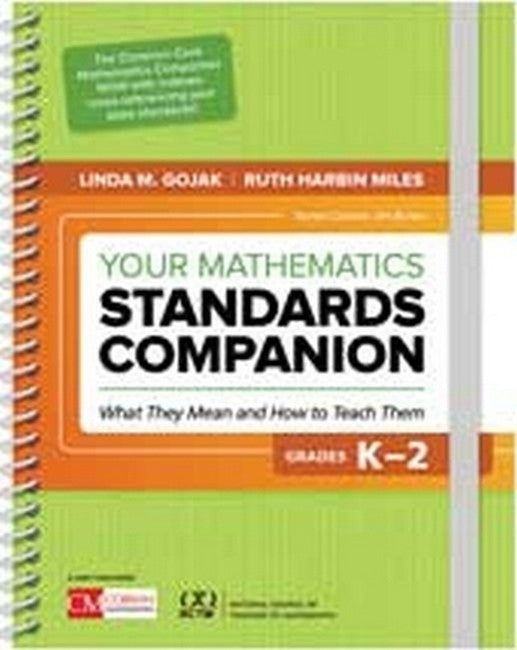Winner of the Presidential Award for Excellence in Science and Mathematics Teaching, Linda M. Gojak directed the Center for Mathematics and Science Education, Teaching, and Technology (CMSETT) at John Carroll University for 16 years. She has spent 28 years teaching elementary and middle school mathematics, and has served as the president of the National Council of Teachers of Mathematics (NCTM), the National Council of Supervisors of Mathematics (NCSM), and the Ohio Council of Teachers of Mathematics. Ruth Harbin Miles coaches rural, suburban, and inner-city school mathematics teachers. Her professional experiences include coordinating the K-12 Mathematics Teaching and Learning Program for the Olathe, Kansas, Public Schools for more than 25 years; teaching mathematics methods courses at Virginia's Mary Baldwin College; and serving on the Board of Directors for the National Council of Teachers of Mathematics, the National Council of Supervisors of Mathematic, and both the Virginia Council of Teachers of Mathematics and the Kansas Association of Teachers of Mathematics. Ruth is a co-author of five Corwin books including A Guide to Mathematics Coaching, A Guide to Mathematics Leadership, Visible Thinking in the K-8 Mathematics Classroom, The Common Core Mathematics Standards, and Realizing Rigor in the Mathematics Classroom. As co-owner of Happy Mountain Learning, Ruth specializes in developing teachers' content knowledge and strategies for engaging students to achieve high standards in mathematics.
Request Academic Copy
Please copy the ISBN for submitting review copy form
Description
Indexes Cross-Referencing Your State Standards Quick Reference Guide Acknowledgments Letter to Grades K-2 Teachers Letter to Elementary School Principals Introduction A Brief History of Current State Standards College and Career Ready Standards for Mathematics Instructional Shifts Terminology Used in This Book Effective Teaching Practices How to Use This Book Reflection Questions Part 1. Counting and Cardinality Domain Overview Suggested Materials for This Domain Key Vocabulary Kindergarten Cluster A: Know number names and the count sequence. Cluster B: Count to tell the number of objects. Cluster C: Compare numbers. Sample Planning Page: Counting and Cardinality, Kindergarten, Cluster B Planning Pages Reflection Questions: Counting and Cardinality Part 2. Operations and Algebraic Thinking Domain Overview Suggested Materials for This Domain Key Vocabulary Kindergarten Cluster A: Understand addition as putting together and adding to, and understand subtraction as taking apart and taking from. Sample Planning Page: Operations and Algebraic Thinking, Kindergarten, Cluster A Planning Page Grade 1 Cluster A: Represent and solve problems involving addition and subtraction. Cluster B: Understand and apply properties of operations and the relationship between addition and subtraction. Cluster C: Add and subtract within 20. Cluster D: Work with addition and subtraction equations. Sample Planning Page: Operations and Algebraic Thinking, Grade 1, Cluster C Planning Pages Grade 2 Cluster A: Represent and solve problems involving addition and subtraction. Cluster B: Add and subtract within 20. Cluster C: Work with equal groups of objects to gain foundations for multiplication. Sample Planning Page: Operations and Algebraic Thinking, Grade 2, Cluster A Planning Pages Reflection Questions: Operations and Algebraic Thinking Part 3. Number and Operations in Base Ten Domain Overview Suggested Materials for This Domain Key Vocabulary Kindergarten Cluster A: Work with numbers 11-19 to gain foundation for place value. Sample Planning Page: Number and Operations in Base Ten, Kindergarten, Cluster A Planning Page Grade 1 Cluster A: Extend the counting sequence. Cluster B: Understand place value. Cluster C: Use place value understanding and properties of operations to add and subtract. Sample Planning Page: Number and Operations in Base Ten, Grade 1, Cluster C Planning Pages Grade 2 Cluster A: Understand place value. Cluster B: Use place value understanding and properties of operations to add and subtract. Sample Planning Page: Number and Operations in Base Ten, Grade 2, Cluster B Planning Pages Reflection Questions: Number and Operations in Base Ten Part 4. Measurement and Data Domain Overview Suggested Materials for This Domain Key Vocabulary Kindergarten Cluster A: Describe and compare measurable attributes. Cluster B: Classify objects and count the number of objects in each category. Sample Planning Page: Measurement and Data, Kindergarten, Cluster A Planning Pages Grade 1 Cluster A: Measure lengths indirectly and by iterating length units. Cluster B: Tell and write time. Cluster C: Represent and interpret data. Sample Planning Page: Measurement and Data, Grade 1, Cluster C Planning Pages Grade 2 Cluster A: Measure and estimate lengths in standard units. Cluster B: Relate addition and subtraction to length. Cluster C: Work with time and money. Cluster D: Represent and interpret data. Sample Planning Page: Measurement and Data, Grade 2, Cluster D Planning Pages Reflection Questions: Measurement and Data Part 5. Geometry Domain Overview Suggested Materials for This Domain Key Vocabulary Kindergarten Cluster A: Identify and describe shapes. Cluster B: Analyze, compare, create, and compose shapes. Sample Planning Page: Geometry, Kindergarten, Cluster A Planning Pages Grade 1 Cluster A: Reason with shapes and their attributes. Sample Planning Page: Geometry, Grade 1, Cluster A Planning Page Grade 2 Cluster A: Reason with shapes and their attributes. Sample Planning Page: Geometry, Grade 2, Cluster A Planning Page Reflection Questions: Geometry Resources Table 1. Addition and Subtraction Situations Table 2. Addition and Subtraction Fact Strategies Table 3. Scaffolding Addition and Subtraction Table 4. Sample Addition and Subtraction Strategies Table 5. Standards for Mathematical Practice Table 6. Effective Teaching Practices Reproducibles Reproducible 1. Five Frame Reproducible 2. Ten Frame Reproducible 3. Double Ten Frame Reproducible 4. Hundreds Chart Reproducible 5. Dot Cards Reproducible 6. Numeral Cards Reproducible 7. Number Line to 20 Reproducible 8. Open Number Line Reproducible 9. Part-Part-Whole Chart Reproducible 10. Place Value Chart (Tens/Ones) Reproducible 11. Place Value Chart (Hundreds/Tens/Ones) Reproducible 12. Comparison Cards Additional Resources About the Authors

